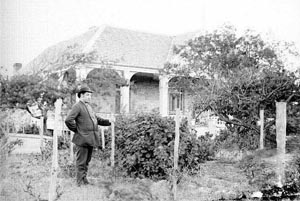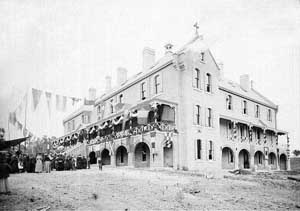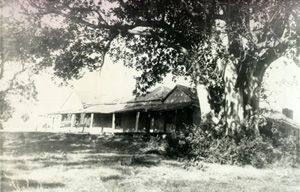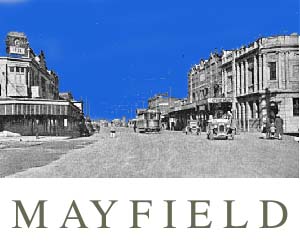
Mayfield Walk No.2
with Helen Marshall
[Whist walking along Crebert Street] G.D.G. There's half a tree! [looking at a stump under a house at 24 Elizabeth Street]. H.M. Most of the old houses up these streets have got trees like that underneath them. That has rotted now, as you can see. It was probably ironbark, an Australian hardwood. They left the trunk, as removing it would leave a hole, and besides it would take someone hours to dig it up. When I lived here, all these bigger homes were by themselves with paddocks. The working people came when the BHP opened and a lot of the wealthy people left. And all their tennis courts and horse paddocks were given over to workers' cottages. |
|
|
[Helen
produces a photograph of an old home in Mayfield which was once the
headquarters of the Young and Green Car yard, now part of the Elladale
community housing estate.] That
was the house of the Manager of the Copper Smelting works over at Port
Waratah built about the 1870s or 1880s. They've built around it a housing
commission estate on the Maitland Road. It was beautiful, they cut the
grass with a scythe, freezias and crocus grew in the lawn. |
G.D.G. I've also got to find out about Waratah House. H.M. Its pulled down. I remember Waratah House, it still had a big glass doorknob on it, and a pine tree lined walk to the river. People took bits of it, floor boards and doors etc. [We walk to 41 Elizabeth Street] G.D.G. Who owns this? H.M. Well, at the moment, a man named Spiro, Mr Spiro owns it. And he bought it because he had a big family, and he was going to extend it, but the National Trust didn't tell him that he couldn't extend it. G.D.G Its beautiful, they should fix it as it is. H.M The man and woman who came to this house, (Mr Gillies and his bride), she was the first white child born out at Jesmond. And his brother was the Mayor of Maitland at the time. His name is on the front of the Town Hall awning. But if you go to Maitland have a look at the name, because they've spelt "John" wrong, fancy spelling "John" wrong! And the stone masons wouldn't alter it, he left it, and its spelt wrong to this day. Its "Jonh", [laughs], he must have had a bad night. And they've had street kids living in there, and they've had several fires. And all the old furniture has been stolen out of it, including a billiard table and a great big sideboard. G.D.G. Ah, its unbelievable that its here, I've never noticed it before. Its such a surprise to see it there. C.K.D.G. So, they've been extending out the side here have they? H.M. They were, but they had to stop about 10 years ago. It could be a beautiful place. C.K.D.G. So, no one's touched it for that long? H.M. A doctor had it when we were here, he lived in it, when we came here, I mean. He was a very sick man, Dr Hemingway. And he just sat out on the front verandah as he was very sick, and his sister lived with him, and she was not well either so they didn't do a thing to the house. G.D.G. So, how old is this place? H.M. Turn of the century, perhaps earlier. C.K.D.G. Well someone's mowing the lawn. H.M. Yes, well they were forced to by the Council. It's a worry to all the people, because the two fires upset the people in next door. [We walk to 38 Elizabeth Street] H.M. This house was built for an American, an American who came out to be one of the bosses of the BHP. And he brought his family out with him, I've got his name somewhere, because people named Croese lived here, Mrs Croese was a friend of my mother's, I've written it down somewhere. And the boy had a very unusal American name, like Homer or [Bud] , yes, something like that. But, it was before my time. And this house, this nice little house belongs to the lady that you met down at the Resident's Group, Margaret Sheedy's House. [Ed. Courtesy of Denise Porter [To No.42 Elizabeth Street] That house was built in 1866. It was built and was burn't down, and the people built it, and the Sheedys extended it. And there used to be a very old house there before they built those flats when I was a young girl. But we'll cross over. [We walk up a lane behind Elizabeth Street] H.M. Now this shed, on the right, there used to be a lot of these through Mayfield, and they were built as grape pickers' barracks, to start off with. Up behind my Auntie's house there were two more until my cousin pulled them down. But this was a knitting factory after it was finished being used as a barracks, there were about 6 to 8 girls working in there for the people named G, who owned the house. They made boy scout socks, because Badon Powell came out to Australia to sign the contract personally to have them make the socks. The girls were paid 10 shillings a week. If they wanted to use the toilet they had to go in the house. Mrs G would complain if they went in twice a day to use the toilet. If the girls were overcome by heat, you could imagine the westery sun, the girls would sometime faint, they would be taken out and laid on the grass. And that's where they would stay till they recovered and went back into work. You didn't go home, you just recovered. And as well as socks, Mrs G's girls made jumpers and skirts and men's jumpers and she used to take them in a suitcase a couple of days a week, as far as Kurri in the train, and all around Newcastle shops, selling these knitted things. And in the corner there was a tiny little shed with a dirt floor where Mr G had a little printing press. And he used to make birthday invitations, wedding invitations, and anything that needed extra printing, or little cards. They were sort of a cottage industry between them, thats how they made a living. And before the Gs came there, they came to live there in 1914, Mrs G told me, and the house was 50 years old then. Before that, a washer woman used to live there, and they had that big yard at the side, putting the washing after all the big houses. She was the local washer woman, I believe it was always full of sheets and towels and what not. But, that was in the days of slave labour. G.D.G. So they re-did the house, but left the shed up. H.M. Well, its of historic value. Brian Sheedy left it because he found out about it, he re-roofed it, he painted it, it's just an ordinary, little, like a garage inside. G.D.G. It doesn't like look like anything that would have that history. H.M. No, its that old, because my grandmother and my auntie had two sheds, twice as big as that in their back yard, but thats another day's story. |
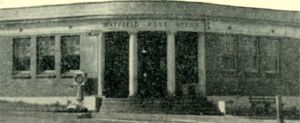 Mayfield Post Office |
[We
walk up the lane to a green house, No.47 Woodstock Street]
H.M. This was an old house built by a man named Southern [Thomas Charlton Southon, son in law to Mrs Croese mentioned below] who was a builder of the first Post Office in Mayfield, (now part of the Mayfied Police Station building). He also helped build the Monastery. [Thomas Southon also built the confessionals at the Monastery, as well as the bank in Mayfield on the corner. His brother was also a Mayor of Waratah]. The family married into a family named Croese, and a lot of them came from the islands, from the islands over there because they were all dairy farms. Well naturally, the sons had to leave and come over to what was considered the "Town", over here, and a lot of them are still living in Mayfield. But, it one of those houses thats been added onto to. [We walk through Liguori Close, which was named after the Italian Saint Alphonsus Liguori to the Monastery] G.D.G. The Monastey is a beautiful building. |
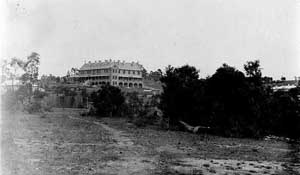 Image of Monastery courtesy of Hunter Photobank |
|
H.M.
This was built about 1887, it might have been opened in 1887, and it
was originally a hill called Harbottle Hill, it wasn't a suitable name
for a Monastery, so they called it Mount St. Alphonsus, I think, or
similar to that. And, a group of brothers who came here, came originally
from an Italian Order. When I was a child, they owned the land stretching
from top of the hill to the Maitland Road. They ploughed this, you could
see the Brothers, with their habits and trousers their rolled up, and
they grew pumpkins and corn all along here. Out the back there they
grew grapes. |
I'll tell you about the Gleeson family from Tipperary. This building was put up at a cost of 2000 pounds, and on the day it opened they collected 4000 pounds! G.D.G. Lots of Catholics around the place! H.M. Well they came from as far as New Zealand, and the Mission from here, as it was not actually a parish, the mission from here went out as far as Tenterfield, out to Coonabarabran. This was a vineyard planted by a man named Daniel Gleeson, who was a Brother. And his brother was a blacksmith, Timothy Gleeson, he came out on a ship with my grandmother. And the son of this Gleeson eventually became the Bishop of Maitland. There were four children in Timothy's family, two girls became nuns and the two boys went into the church as well. Daniel, Bishop Gleeson's uncle, tended to all the vines here, that was his job, he was devoted to growing things. They were still here when I was young, in the late 1920s and 1930s. The Brothers are still here. They are a credit to any religion, that's what I think of them. When Timothy Gleeson became a very old man, there was no one to look after him, so they admitted him as a Brother, and so kept him up here and looked after him. Bishop Gleeson would come up to visit him from Maitland until he died, sometime in the 1930s. And when they had the wakes here, my mother had a shop in Mayfield, and we use to, my sister and I, would bring up, for all the wakes, a suitcase of cakes. Until we got about 16 or 17, and Bishop Gleeson told us we weren't to come back anymore, he said, "You can't come up here anymore". And we were very haughty and upset about that. We'd always brought the cakes to the gates over there and waited, and someone came down for them. But, I often think of him coming along to the gate and saying "What are you girls doing here?" And we said, "We're Mrs Steven's grand daughters" and he said "Oh!", and he was quite surprised, I supposed he thought we were children. So the brother collected the shop's cakes after that. Another good thing they do here, is that they let the children play in the front yard. They can play football, any boys around here can play football. Boys only. But they're not allowed to swear while they're here. And another thing is that ever since they opened, they've had a kitchen out the back, where, if you rang a bell, I've never done this, but if you rang a bell, someone would come to the back door with a tray, with a can of tea on it and a plate of sandwiches and some cake or anything, a tray of food. For people in need. And just until about two years ago they did this from when they opened. And then a home was built over there for deliquents, or a halfway house type thing for boys, young men from prison, and they believe it was them who broke in and robbed the place, so many times, they stole from the kitchens, the brothers haven't replaced... and they stopped the service. So no one can get any help at the back door now, which is very sad. It's a shame to see a custom like that die out. There was a man [Mr Brickman] living opposite the Monastery, who lost his hand in an accident. Apparently, a heavy horse drawn cart with steel tyre had run him over. He was given a hook in its place and the brothers gave him a job taking down the old high wooden fence. And another thing, there's a well somewhere here, and see when there was a drought, people would come up here to get water to do their washing. Now, there is water under there, (she points to a concrete lid), I don't know if that's the well or not, or just a cistern from the drain. I wouldn't know if its the original well. C.K.D.G. I wonder how far you have to go down here to get bore water? H.M. Well, I don't think you'd have to go very far, its all sandstone under here, sandstone ridge from out the west up to Mayfield East. And I think the layers of sandstone let the water lie there. [Looking towards the Monastery building] There's a beautiful staircase up there, and I never been up that part, but I've been up there, and the walls up there must be that thick, very very thick walls. Its a lovely old building. There's a celtic cross here, [in commemoration of the earthquake of 1989]. G.D.G. That's the earthquake. H.M. I don't know where they came from, they look older than the earthquake, don't they. G.D.G. Yeah, they do, beautiful work isn't it. H.M. Yes, its a perfect circle. I say they would have had to have taken it down. Look what happened to the Church of the Sacred Heart. [Sound of singing can be heard coming from the church] There's Italian marble in here. C.K.D.G. In the church there is a beautiful mosaic of angels. H.M. The church was built in 1906, I thought it was much older than that. The monastery building was prior to the church in 1887. When they started to build it, alot of the things had to come, whatever the furnishings and the timber, they had to come from Sydney, and they brought them up by ship to Newcastle Harbour, and then they brought them out here by bullock wagons. It took a day to get here from Newcastle. G.D.G A day from Newcastle? H.M. Yeah, with a bullock wagon, well have you ever seen the pace a bullock wagon goes with a load? And Throsby Creek, near the Tech , where the bridge is, they use to stop there and boil the billy for lunch, I think, when the monastery was being built. G.D.G. Its takes us 15 minutes now. H.M. See, if you have roads, and you want to go out to Lake Macquarie, you can say half an hour at the most. But, if you have no roads, what do you do? People laugh sometimes and say "Oh" but if you didn't have a road, or a car... G.D.G So, it was like a track that most people followed? H.M. Yeah, that's right. But we use to go out, my sister and I, on holidays to Lake Macquarie, with my aunts and uncles, and write home to mum..write letters home...its just a just a different world. People thought that everyone drove around in buggys and carriages, but they didn't own them, people were poorer.And there was a beautiful home in here, built for a manager of one of the works, not BHP, one of the others, a Mr McDougall lived in it. A huge home and they pulled it all down, it had cedar fittings in it, and they built all these. [We walk to Bull Street] This was all monastery land, there use to be a house here that belonged to Mr Bull, he was an old resident around 1860. [To the top of the hill to Heritage Estate, and looking over to the Steel River site, with the "new orphanage" still visible] That use to be full of rabbit holes when I was young, we use to bring our dogs up to flush out the rabbits. They'd be rabbits running everywhere! That new orphanage took the place of the old orphanage, which was the home of the Manager of the Australian Agricultural Company, which was started by John Macarthur. And that pine tree is a Cooksey Island pine, and I believe it must have been planted by the first settler, a man named Platt, but I don't want to talk about him until we get over there. But along here, where the main park is, across from here was the big unemployment camp, where the families lived, husbands and wives and children, and just beyond that, behind the orphanage, was the place where all the single unemployed men lived. They didn't live together beacuse they said it made trouble. And the river ran at the foot of that hill, directly around around the hill. But that hill seemed steeper, not because the hill has grown, but because they filled this all in, that was very deep. G.D.G. Where have they filled in? On this side of it? H.M. No, the other side. See, the Cooksey Island Pine and that shrubbery is part of the garden that was around the AAC house. And it was almost a steep drop down to the river on the northern side. G.D.G So, its all been filled in now. H.M. Yes, and the Spit Island is where that factory is [i.e., the Manganese Plant]. And the river came right along here, where those green buildings would be, that would've been the river along there. They had schools, they had a little street about half a mile long on Moscheto Island. Someone took a motor car over it on a launch. People made their own lauches. They were fishermen and farmers. And they use to take the cream from their farms up to the Black Wharf at the base of Ingall Street. 'Black Wharf' was its formal name. And the children from the island use to come to my school, they'd row boats and have to walk up the hill to Mayfield East School. And the reason the farmers were more or less willing to give up the land, the salt water started to seep up into their fresh water. They wanted the Council to build a dam or weir to keep the salt water back. That's why I'd like you to get a car and we'd drive up there, up to the new orphanage, and have a look right along, you'd get a better idea. There use to be a quarry up there, and a coal mine over there, just behind the red brick building, there was a coal mine, with wooden rails going down into the river because they use to ship the coal down the river. [Looking towards our side of the Industrial Highway on the hill] G.D.G So, this is going to be all residential? H.M. Yes, this is what they call 'Heritage Estate', [..inaudible..] plus with the noise of that traffic all the time, they've put up a wall, but its still not enough. Mr Clive Curtis and I worked up in that bush, clearing it all, getting rid of weeds, and he spent $100 worth, of his money, on little trees and planted them further over, and we were told to get out, about eight years ago. And he got killed by a train on the railway line at Waratah. And I couldn't go on with it because they wasn't anyone else to help, besides, BHP didn't want us to, because all this use to be, and still is Council land, but the BHP wanted it for some reason. There was a park up there, between the new orphanage and the road, a park known as Boomerang Park, and they started carting the rubbish up there and locked the gate. They've taken it away now, in summertime...[inaudible]..Up on that hill is the home of a man, use to be the home of a man named Mr Delprat - a V.I.P.. He was a big man with the BHP, he had a two storey home in Mayfield. [Continue walking, sound inaudible due to wind blowing at top of Bull Street] G.D.G. So all this was vineyards? H.M. Yes. G.D.G The whole lot? H.M. Well, even when I was young there were vineyards. G.D.G. So what are you saying, there were vineyards all the way down to the road? H.M. Not in my time, in my time there were still pockets of vines, and down where they call Pommy Town, they tore out most of the grape vines to build homes for the 120 families, for people who came to work for the Lysaghts Company. G.D.G. I've been trying to kill a vine for the past ten years, vines just seem to love the ground here. All the Italians still make wine here. [We walk to the east towards BHP along Bull Street] No.65 Bull Street This was built by a very early member of Parliament about 1880. And, when I was young it was the only house up here, on this side. And, just before I remember it, it was a private school, and when I was young you could go in there and the forms and the school desks were still in there, its a huge place, you can't possibly judge how big it is from here. [We walk towards the back of the building with a view of Tomago in the distance] G.D.G. Its quite enormous, isn't it, and a steep drop down. H.M. That's the Tomago place out there, and that's Buledelah Mountains further up, through there. My son says we get more fall out from Tomago aluminium than anything else, he says we're the right distance for the particles to fall on Mayfield. My son works for Alcan. G.D.G. We usually think of these aluminium places as clean. We don't usually ring the pollution control complaining about them, because you can't see them. Is this stuff harmful? H.M. Well its not good! [coughs] G.D.G. This one over here I've been waiting for this to be fixed. [Across the road] H.M. It never will. Not now. Its now a home for people in a sheltered situation or something. It use to belong to Cowie, a businessman named Cowie, and it had the bull nosed iron verandah and beautiful iron lace around both verandahs. And those steps were built there, so the maids could empty the chamber pots for people without going through the main living area. C.K.D.G. It looks like its been there for a while, but it doesn't look like its going to be there much longer. H.M. It was there in my day, I remember it, because we knew a lot of the girls who worked, in these big houses, were only 14. These women would hire, I always sound so bitter and against these people, I'm not really, but I'm looking at it from my age/generation. Girls of 14 would be employed by these people, whose job was to strip the beds, and make them, and empty the chamber pots, which they used for both purposes, and would be a very unpleasant job, because that saved the big people from coming down the stairs to the toilet. They'd also prepare the meals, then, in the afternoon they would get dressed up in a little cap and a little frilly apron and they'd serve afternoon tea. And I remember once, my sister and me walked past and we saw this girl serving afternoon tea and she came over to the window, she must have been told to draw the blind or something, and she pulled a face and stuck her tongue out, and then she turned around with this real calm expression and picked the tray up again. They were kids of 14 and what they expected was someone like an english butler, but I mean these children would only have been in an home where they had a plate of porridge with a newspaper for a tablecloth, and having to have really poised and sophisticated manners. That was Cowie's there. G.D.G That's a big home down here. H.M. The man who owned that worked for the BHP, he was an accountant, but he was also ...[that 's the lady of the house there, I'll see if she'll talk to us, ...when I was young there were one or two brick homes only and this wasn't here, this was the tennis court belonging to this home. G.D.G. It would be difficult living in a home that was just a tennis court. H.M. [laughs] Everybody would have a tennis court if they had a big yard. And by the way, at the end of this street (Barton Street) was a big pottery works, remember in Crebert Street, I showed you that house, and you said with those maingey looking lions, that was Deans Pottery down there on the riverbank. G.D.G This is Elizabeth Street, down the end of this street. H.M. Well, sort of between here and Barton Streets. As I said, everything has altered so much, and they had a huge clay pit which was a big dam, where they dug the clay out, and it had a little train from the clay pit into the pottery works, and they sent all their pottery down to Sydney to be sold, on a boat, that came up to the river. G.D.G So, there is pottery floating around that s got "Made in Newcastle" on it? H.M. There were lot of potteries here, there was over over at where K Mart is now [in Waratah]. G.D.G. [Walking further down Bull Street] Well, that's another immense place too, in the old English tradition of a laboratory, library, study, and all that sort of thing. H.M. This man, Mr Howarth, use to let anybody come up and look at the stars, through his telescope, and my mother would never let us come here. The pollution became too much and the stars weren't visible. [To No.38 Bull Street] This belonged to Lesley Arnott. There were three Arnott's houses in Mayfield. This house was neglected all through the Depression, I don't know when Lesly Arnott was supposed to have moved out, but some of them moved into the stree where the W.E.A. is now [Union Street Newcastle?], Lesley was the businessman behind all this, the son of the original Arnott from Morpeth. Underneath here were the maids' rooms, and the basement area we cannot see. [ We spot a cement swimming pool] I think when he built it, for some reason it was too shady. The man who built that, and bought this house, about twenty years ago, he spent a fortune on it and he was a milkman. It must have sent him bankrupt because he wanted to restore it. Anyway, underneath that bottom story where the maids lived, when I was a child, a man named Cook lived there, with a whole lot of dogs. And he would speak to us, and then he'd whistle, and all these dogs, about twelve dogs, would come hopping out of windows, out of doors, rushing, rushing [laughs]. [Walking down to the Christian Community School along Bull Street] That's, actually, where the golf course was. G.D.G. How long ago was this? H.M. Almost till the war broke out, until about the late 1930s. And the golf course extended the club house in this street, yes, the club house would have been half way up that street, where the school is, and it took in Waratah House. But in Waratah House the BHP stored hay for the horses. G.D.G. So, this is where Waratah House was? H.M. No, down on the flat, approximately where Tubemakers office is, was the original location of Waratah House. BHP would store hay in it, for the horses. A beautiful big home. |
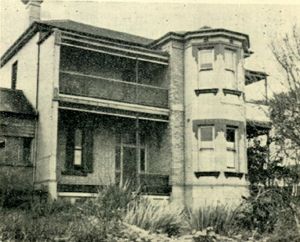 Windeyer House |
[We pass a house] And this home belonged to judge Windeyer. It's in Kerr Street, as far as I know, it faces that way, Kerr Street was his driveway. That means it was built when there were no roads, I'd say. And it was then, after the Windeyers left, that it became the first catholic convent. We'll go down as far as Simpsons Cottage, but we won't go up Pommy Town, 'cause that's a bigger walk. This is one of the Pommy Town houses. [She points out a number of typical Pommy Town house] H.M. Simpson owned Waratah House, have you read about him? He was a collector of customs. And he had a great gravel path down to a jetty on the river. And he was rowed down the river every day to work. Someone said it was a convict crew, but I don't know about that part. And you can see Scholey's house, see the two big homes up on the hill? Scholey's on the right with a round circle, that's the one that's now a hostel, and over there that's William Arnott's House, with the veradah closed in with the one chimney on it. The one that use to have the big fountain out the front. You can see this would have been a beautiful view right down to the river. G.D.G. And that other one, that first house there. H.M. That was Winn's. Winn's house. That was the place [entering Cowie Street] And there's Wye Street, they're all English names, Avon. This one's another Pommy Town house. [No. 6] There were 120 families, so you can imagine there were quite a lot of homes, and they made an impact on the school. This mean't that I went to school with english children. G.D.G. Were they well off? H.M. They were working people, but, they were better off than most. When I look at the photos, all the English children had shoes and socks and jumpers on in the winter. They were better dressed than the Australians. [We walk towards the Industrial highway] Where the entrance to Tubemakers is now, is where Waratah House was down there, and the golf course came right along. |
G.D.G. When did they knock down Waratah House? H.M. I think it was around the beginning of the War, around 1940, because my father went out to sketch it, ca.1939-40. When they expanded all those industries, there were dairy farmers all along here. Mr Ranclaud had a dairy, up further. [Continue walking] Another Pommy Town house...[to Simpson's Cottage on the Industrial Highway] The Mr Simpson who owned Waratah House had this built, and they all say he didn't live in it, that his son did. His son lived in it, and had a housekeeper named Mrs Goddard. G.D.G [We read the plaque outside the front of Simpson's Cottage, at the time, circa Aug 1995, an outback art shop] The plaque says "12th October 1852" H.M. Yes, in the 1930s one of the Simpsons lived here, and naturally, because he owned it, he didn't pay himself rent. No record exists of him having paid rent, and I am the only person that insists that the son of that Simpson lived here, in the 30s, when was a very old man, who couldn't move out of the chair and he'd have the house very hot. And right all up the back was vineyards, when I was young, the whole area there was vineyards, behind Pommy Town, and there was a well, around the corner there. G.D.G. I didn't even know this was here, it looks like a recent building. H.M.There's not a thing that been altered, in my opinion. The bars were there, on the windows, I remember those, because my sister and I loved this house. But, that kitchen was very very hot, and Mrs Goddard would cook there. That brick bit at the back been's added on, it was only small, some said he built it for workmen. The Simpsons never lived in it except for Mr Simpson's son, who lived here in the 30s. See, he would have been in his eighties then, and so, they put him in a home after that. Waratah House was there, and there was a beautiful big stone house through there, that was in good order, and they pulled that down as well. G.D.G. These things would have been down there on the river bank? H.M. They were right on the river bank before they filled it in. I think it was Dairy Farmers house, but then, the AAC built very big houses for their bosses. Over where the school is, after the golf course was closed, they put a lot of coal there, a large area for storing coal. And when there was a big freeze one winter, the electricity all went off in about 1952, the people went there, with wheel barrows and things, and dug down for coal to burn for fires. Do you know the Working Women's Centre? The original part of it was built by the English, I should say Pommy Town, that's what it was called, and they had bands and their own entertainment, their own clubs. G.D.G. These houses in Pommy Town, they were'nt all built in the one area were they? H.M. Yes they were. Avon Street and Vine Street, one or two are in Kerr Street. They lived close to Lysaghts, they walked to work, and when the temperature got hot, or reached a certain temperature, part of their agreement was that they could go home, which they did. You can see now that Windeyer's house faces this way. They brought indentured servants out from Ireland. [Continues walking] Usk is an English name. There were a lot more tennis courts down there, there was one near Lesley, William, whoever the other Arnott brother was, they use to play tennis up there and the butler would come out with a plate of drinks, dressed formally, in a bow tie and black suit, to serve the players. G.D.G. It's difficult to imagine that English time and style existing here. H.M. Well a lot of people came from India to here, you know the British Raj, who couldn't take the cold climate. [Walking up towards a horrible pink building] This building was closed in and made into flats, it was quite different looking, and it didn't have that horrible pink. The indentured servants, one of the Irish servants, a girl of thirteen, was very badly treated by this family. And the mistress of the house, the Windeyer, would watch what she ate. She wasn't allowed to use butter, she had to have margarine. The mistress would, it was like something out of Charles Dickens, she'd cut the meat off for her, and, you can imagine a child of thirteen gobbling everything up, wanting to eat everything including the cold cuts of meat. When she grew up and got married, her son became a big businessman in Newcastle, a well to do man. And I think she made him that, out of revenge, I'd say. He worked hard, but he started off as an apprentice, and worked up into his own business and who employed about 50 people. [Walking past Lesley Lodge] G.D.G. All these little back streets and throughfares. H.M. I don't know what the purpose of this lane would be. As far as I know, it wasn't for night carts, because, they had the sewerage on very early around here. G.D.G. [Walking towards the house with the concrete pool in the backyard.] I can't get over that pool. H.M. It's ugly, actually he spoilt the house. This street has houses very close together, and they were all built for workers from BHP, during the 1930s. The pottery works were quite a big concern. There was a man named Con Dempsey, who lived in Mayfield, and whose job was a night watchman for the Mayfield business area, and for the pottery works. And all the business people would put in so much a week, and would pay him to guard their property. And his whole job was to walk around the shops and around the main street, at night time. [We walk down Elizabeth Street from Bull Street towards home] H.M. This whole area around here belonged to the McDougall's house. It belonged to one of the of the big men who had a housekeeper. If you had to take a message up there, you had to go to the trades entrance, you didn't take it to the front door. And the house was somewhere, actually that front bit there looks like the house. [We pass 58 Elizabeth Street] And this is an old house, and underneath it is a big tree too. These are not Pommy Town houses, they were just similar in build. Kerr Street is very interesting too. G.D.G. I'm interested in what they used to make around here. What sort of life was here before the heavy industries came, what sort of things were produced in Mayfield? H.M. Well, the business people moved out here, and a lot of people worked for them. And they were gardeners, and believe it or not, there were a lot of music teachers, strange as it may seem. There was one in every street. There were dress makers, women were dress makers. There were Council workers, because the roads were kept, remember there was no machinery, everything was done by hand. If the road had to have bitumen, the men would come out and dig it flat with shovels or with a horse, so, that there were people who looked after horses. The rich people had to have people minding their horses. Everything created its own work. There were coal mines, alot of little ones, ... G.D.G. Close by here? H.M. Well, there was one at Burwood Colliery at Merewether, they had a little train line along Merewether's forshore there. They had train lines coming across Hunter Street, you'd be pulled up in the tram, waiting for the train to come through. And there wasn't the population, the industries brought the population.There were lots of small industries in Mayfield, most in backyards. One small factory was at 15 Woodstock Street. There were pattern workers, spring makers, blacksmiths, small iron foundries, a stainless steel and copper items works, and plaster works in Hanbury Street, in quite large wooden sheds employing about a dozen men. Most only employed two or three. At the plaster works they kept the doors open for ventilation and I remember the men sitting on logs on the ground to eat their lunch. Also, men came to the back door to sharpen scissors, mend pots and pans, sell fruit, sell eggs, honey, rabbits, honey and clothes line props. Also, some shops had entrances, doorways and floors made of rough cut slabs and you couldn't walk on them without shoes. One day a child borrowered my shoes off my feet to go into Mrs Oliver's shop in Mayfield while I waited bare footed out on the footpath. A set of shops in Hanbury Street also had a whole verandah frontage of slabs. They were called the 'Sunnyside' shops. One place made cement laundry tubs. The Dodd's family were pattern makers in Hanbury Street. They were near the R.S.L. Club. The ladies wore little silk night caps to bed. Some teenage boys would gather ferns from the bush and carry them in bundles on their bicycles to the butchers, who bought the ferns for their windows. The meat was placed on the ferns and water ran down the glass for coolness. But some health law stopped the use of ferns, and artificial ones were used then. When the soap works in Mayfield closed down, the children at school whose fathers were now unemployed, cried all day. They expected to go to the camp on Platt's Estate for the unemployed. Landlords put them out on the streets for non payment of rents. I saw such sights fairly often. [No.39 Elizabeth Street] The owner of this house now is Spiro, street kids and pigeons nest in it now. Two smashed cars lie behind, the shed with a ruin where the old copper stood to boil the clothes and kill the germs. Spiro's father owned a fruit shop in Mayfield, and young Spiro would be about 50 or so now. Transcription of interview with Helen Marshall conducted in the winter of 1995. Originally transcribed in 1998, with corrections and additions in March 2000. Extra correcions and details concerning the Croese and Southon families were kindly provided by Denise Porter. Some images are courtesy of Hunter Photobank and Picman Database State Library. Copyright
2000 Helen Marshall and Gionni Di Gravio
Back to the Mayfield Website |
